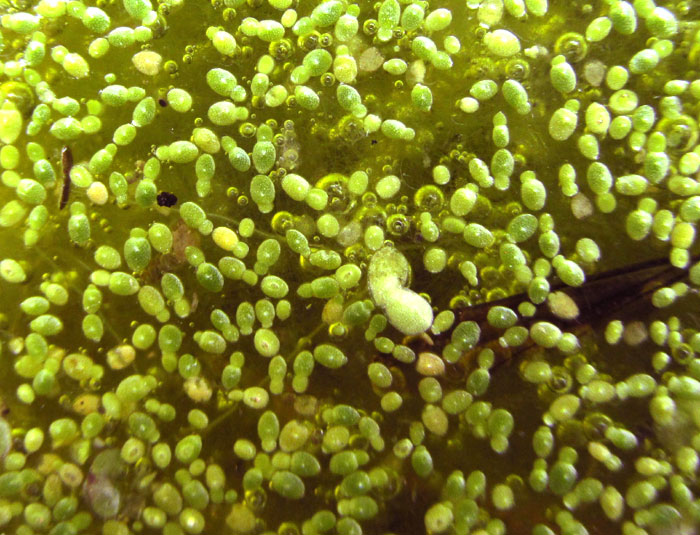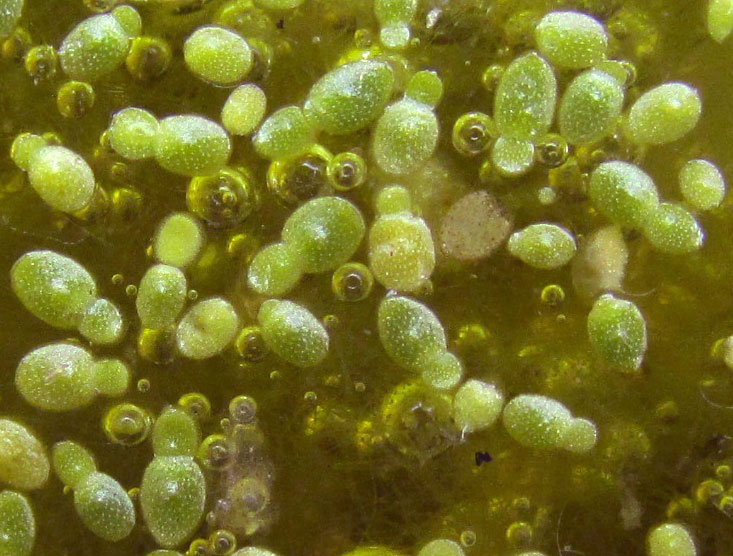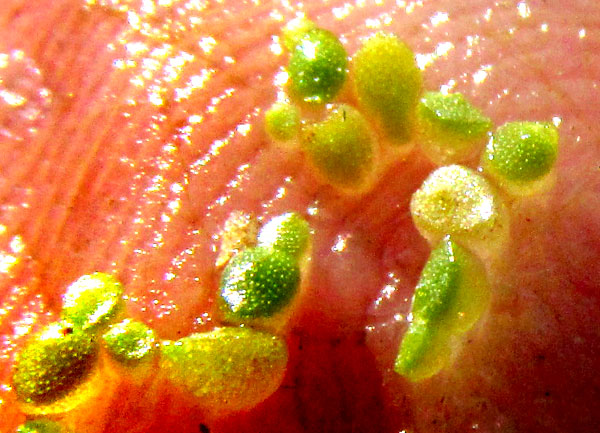Excerpts from Jim Conrad's
Naturalist Newsletter
entry dated May 21, 2022, notes from a camping trip among hills about 7kms ENE of Tequisquiapan, Querétaro state, MÉXICO
elevation about 2020m (6700 ft), near N20.57°, W99.85°
BRAZILIAN WATERMEAL

Near a small spring at the base of a cliff wall, years ago a rancher made a cement cattle watering trough. The ranch's soil has long eroded away and the ranch itself abandoned, but the trough remains, and so does a rusty pipe stuck in the cliff wall, dribbling cool, clean water into the trough. All during the day, from all around, birds, insects and other creatures come to drink. The trough' water is green with algae, and the surface is covered with tiny, oval Brazilian Watermeal plants, WOLFFIA BRASILIENSIS, shown above. In that picture, the silvery, spherical items are bubbles of oxygen generously produced by the algae and watermeal.
Wolffia brasiliensis belongs to the Duckweed Family, the Lemnaceae, and often is thought of as a duckweed itself. However, the main duckweeds people envision when they think of duckweeds have flatter and considerably larger floating bodies, and bear threadlike roots that descend into the water below the floating blades. You can see such larger, root-bearing species on our Common Duckweed and Spirodela Duckweed pages. The picture below shows our watermeals closer up:

Several watermeals in that picture consist of a larger body attached to a smaller one. Members of the family, though capable of producing flowers and fruits, mostly reproduce asexually, by budding. The pictures show several individuals in the process of budding new plants. Often in small bodies of water like our watering trough, all the plants are clones of a single original individual, which may have invaded the trough years ago. Such introductions most likely come about via a microscopic seed stuck to a bird's leg in a thin layer of mud. This is even more likely with the genus Wolffia because species in this genus produce the smallest fruits of all the world's flowering plants. In the US, Wolffia plant bodies have been reported being distributed by a tornado, as well as being found in melting hailstones.
Another feature to notice on some of the above plants is that, according to the manner light reflects from the plants' tops as a silvery sheen, many of the tops rise in their center to a low, rounded peak. Below, on a fingertip, some watermeals show their form better in side view -- their low peaks on the top part and their greatly bulging, rounded bottoms:

The Duckweed Family consists of about 37 species in four or five genera. Our plants are the genus Wolffia for two reasons: They don't bear roots and; their bottom surfaces are rounded, or convex, not flat.
Worldwide about 11 species of Wolffia are recognized, but the Flora del Bajío -- with our location found in the Bajío region -- reports only two species in our region. Of the two, Wolffia columbiana lacks the little mounds on the top surface, known as papilla. Since ours has papilla, it's Wolffia brasiliensis.
Brazilian Watermeal specializes in quiet waters in temperate to subtropical regions of the Americas, but is described as absent in the Old World.
Many smaller fish species, especially the young, feed on watermeal. Since the plants can reproduce exponentially by budding, under the right conditions they can fairly quickly produce huge amounts of biomass. Already fish farms are using the plant as fishfood, and in certain Asian countries traditionally it's been used as human food.
In 2018, Klaus-J Appenroth and others published "Nutritional Value of the Duckweed Species of the Genus Wolffia (Lemnaceae) as Human Food." They found that in terms of freeze-dry weight Wolffia species consist of 20-30% protein, 10-20% starch, 1-5% fat, and about 25% fiber. The essential amino acid content was higher or close to the requirements of preschool-aged children, according to standards of the World Health Organization. Mineral content could be managed by cultivation practices.